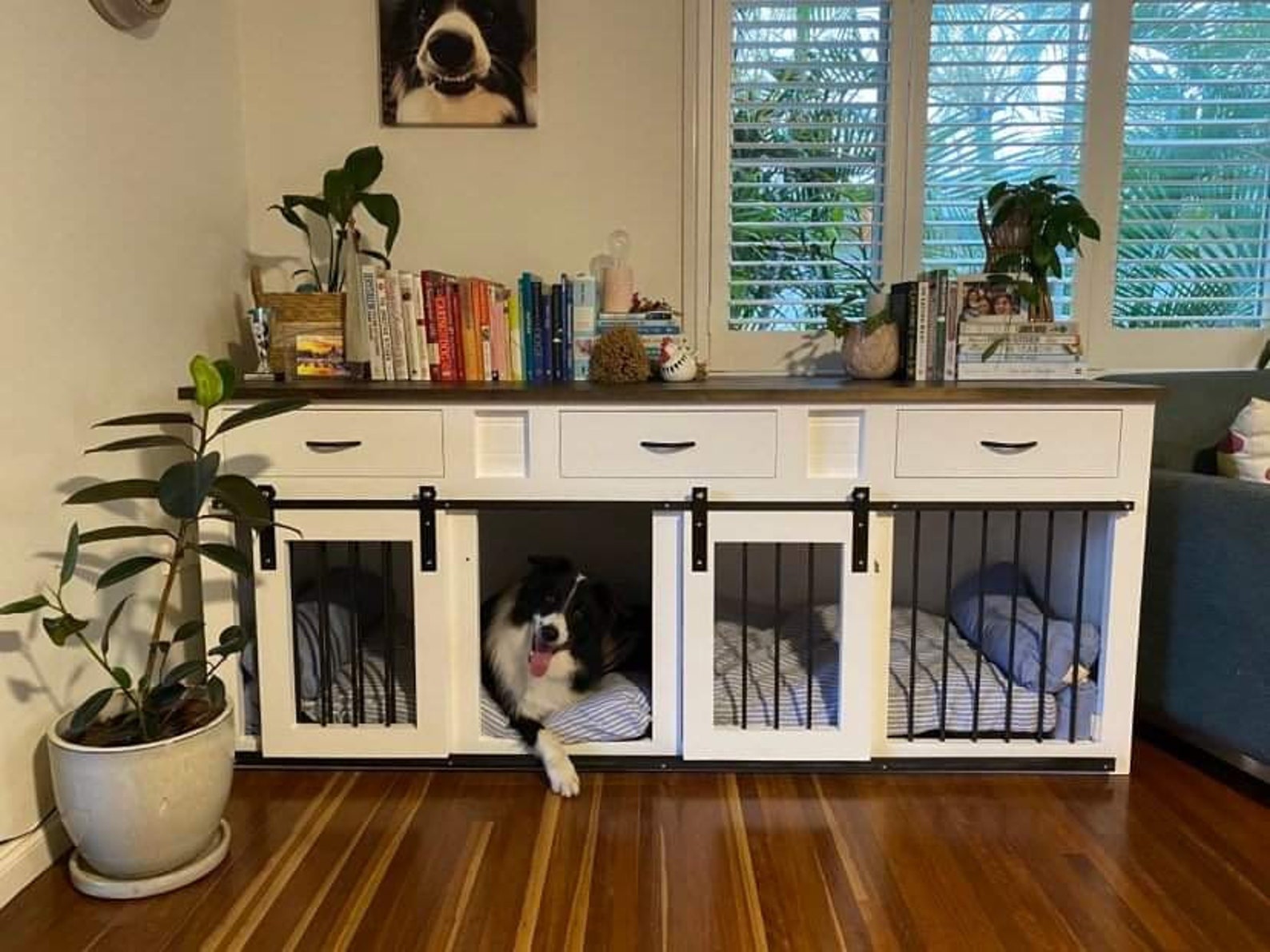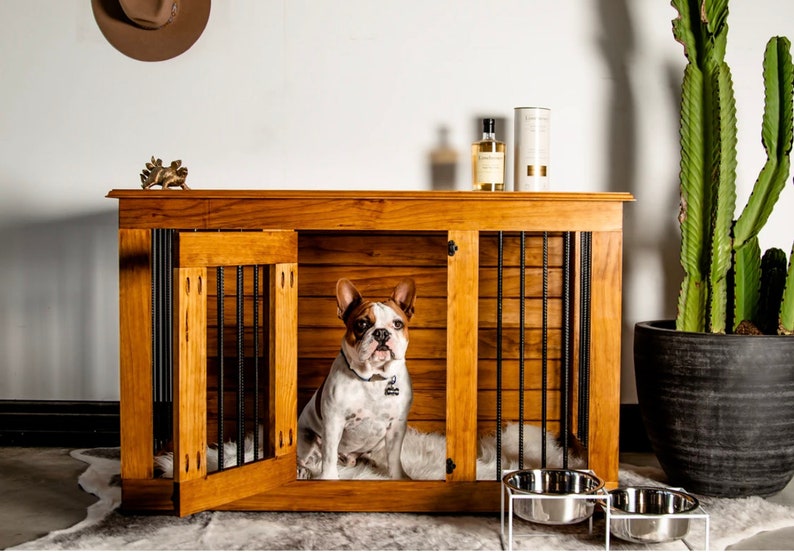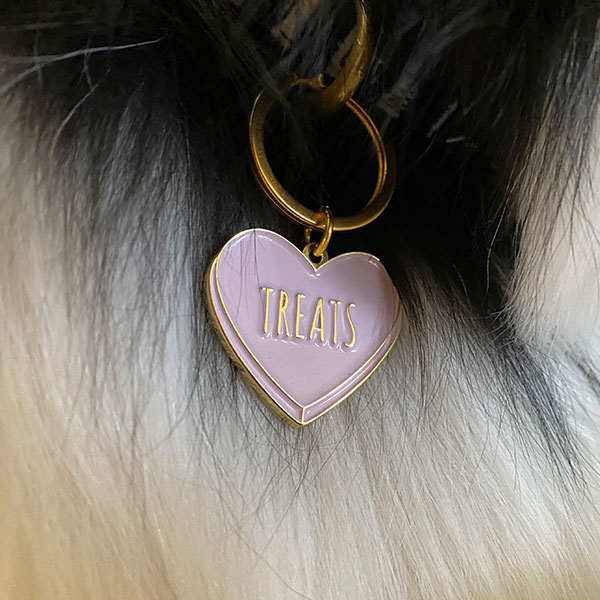Disclosure: Dogs of Australia is reader-supported. When you buy through links on our site, we sometimes earn an affiliate commission at no added cost to you. Learn more
If you’re looking for dog crate furniture ideas, you’ve come to the right place! Here in Australia, we love our dogs and want to provide them with the best possible lifestyle. That’s why dog crate furniture is becoming more and more popular – it’s a way to give your dog their own space while also adding a beautiful new piece of furniture to your home.
In this article, we will discuss designer dog crates, wooden dog kennels, and other types of furniture that can be used as a dog crate. We’ll also provide some tips on how to choose the right one for your pet!
Table of Contents
ToggleDesigner Dog Crates by The Paws Room (Brisbane, QLD)
At last, a stylish dog crate that gives your best friend a safe space while seamlessly blending in with your decor.
Australian made and designed, The Paws Room dog crates serve as furniture for shared living spaces and better enable a sense of belonging for the whole family.
Made from premium birch plywood, Teddy (the designer dog crate) and Jack (the luxury crate cover) slot together easily in under 5 minutes with minimal tools (or skills!) required.
Visit The Paws Room’s website to learn more about their dog crate and accessories collection. You can also make a booking to visit the showroom in Brisbane via their website.

Wooden Dog Crate Furniture by Unique Pet Furniture (Toowoomba, QLD)
Unique Pet Furniture is based in Queensland and handcrafts a wide range of custom-built wooden dog crate furniture.
Starting from $450, every cabinet is 100% uniquely built to your specifications, and you are in full control of your build, from size to style.

Wooden Dog Kennels by Kustom Kennels (Perth, WA)
Kustom Kennels is based in Perth, Western Australia and handcrafts wooden dog kennels from pine wood and metal rebar.

Designer Dog Crates from Etsy (Overseas Sellers)
There’s also a wide range of luxury dog crates available on Etsy, which can be created to your specifications by talented sellers worldwide.
A popular dog crate designs is the Triple Dog Kennel with Divider by ElevatedDogBowls (Ukraine).
However, if you buy from Etsy, please be mindful of shipping costs, as wooden dog crates can be heavy and expensive to ship.

Another popular designer dog kennel on Etsy is the Modern Dog House by NicePeopleWorkshop (Ukraine). It comes with a transparent acrylic door which is very solid and easy to use.

Frequently asked questions about dog crates
Let’s dive into some of the most frequently asked questions about dog crates and their answers.
What room should a dog crate be in?
Your dog’s space should be close to where you and your family spend most of their time, but not necessarily right in the middle of all the action. So, in other words, you want to make sure that your dog does not feel isolated, while also providing your dog with a place to unwind.
How can I make my dog crate more cozy?
Adding a dog bed to your dog’s crate will make it more comfortable. You can also provide your dog with an item of clothing that smells like you, which can sometimes help ease symptoms of anxiety. If you’re still in the process of crate-training your dog, you can also try placing a few treats inside the crate to make it more enticing.
How big should my dog’s dog crate furniture be?
You can use the measurements of your dog to determine what size dog crate you should purchase. Your dog should be able to stand, turn around, and stretch out comfortably inside the crate furniture. Most brands offer small, medium and large sizes for their products so that customers have different options when choosing which one is right for them! If you’re unsure, don’t hesitate to contact the brand you’re thinking about buying from and they’ll be happy to advise you on the right size for your dog.

How much does dog crate furniture cost?
Dog crate furniture can range in price depending on the size, brand, and materials used. If you’re buying locally, prices typically start at around $500 for dog crate furniture. However, they can quickly become a lot more expensive if you’re looking for a bigger piece.
As a cheaper alternative, you could consider buying a wooden dog bed with a seperate dog pen that you can set up when you need to seperate your dog from the rest of your household.
How do you crate train a dog?
Crate training a dog can be a helpful tool for housebreaking, providing a safe space for them to rest, and reducing separation anxiety. Here are the steps to follow when crate training your dog:
- Introduce the crate gradually: Start by leaving the door open and putting a treat inside the crate. Gradually increase the time your dog spends in the crate until they are comfortable going in and out on their own.
- Make the crate a positive place: Place a comfortable bed and toys in the crate, and offer treats and praise when your dog goes inside.
- Gradually increase the time spent in the crate: Start by keeping your dog in the crate for short periods of time, and gradually increase the duration over a few days or weeks.
- Use the crate for short periods: At first, use the crate for short periods such as when you leave the house, or during meal times. Gradually increase the length of time they spend in the crate as they become more comfortable.
- Avoid using the crate as punishment: The crate should be a safe and positive place for your dog, not a place of punishment.
In addition to the benefits of crate training for housebreaking and providing a safe space, it’s also important to ensure that your dog is comfortable being inside a crate even if you don’t plan on using one on a regular basis. This way, if they ever need to be in a crate, for example at the vet, they will not be stressed or anxious. By crate training your dog, you can help them feel comfortable and secure in a crate, reducing their stress levels in any situation where they may need to be in one.
By following these steps, you can help your dog develop a positive association with their crate, making it a safe and comfortable place for them to rest and relax.
How long can a dog stay in a crate?
This is a question that’s best discussed with your veterinarian, as they can provide personalised advice based on your dog’s specific needs and health status. Factors such as your dog’s age, size, breed, and activity level can all impact the length of time they can stay in a crate.
In general, puppies under six months of age should not stay in a crate for more than three hours at a time. If they are significantly younger than six months, such as a 12-week-old puppy, they should not be in a crate for three full hours. Meanwhile, adult dogs can typically be crated for up to eight hours. However, it’s important to remember that every dog is different, and some dogs may need more frequent breaks from the crate, while others may be able to stay in for longer periods of time.
Your vet can help you determine the appropriate amount of crate time for your dog, taking into account their physical and emotional needs, and make recommendations for how to ensure they are comfortable and happy while in the crate. By working with your vet, you can help ensure that your dog is safe and healthy while in the crate, and prevent any potential negative consequences.
How can using a crate help with toilet training a dog?
Using a crate for your dog can be a useful tool for toilet training. The idea behind using a crate for toilet training is to limit your dog’s access to the house, so that they are less likely to have accidents inside. By using a crate, you can also control when your dog goes outside to relieve themselves, which can make it easier to establish a consistent potty schedule.
However, it’s important to ensure that the crate is the right size for your dog and that they have enough space to stand, turn around, and lie down comfortably. Additionally, you should never leave your dog in the crate for extended periods of time, as this can lead to boredom, frustration, and other behavioural problems.
So, what are the benefits of using a crate?
Whether it’s a normal indoor dog crate, or a designer dog crate that acts like a piece of pet furniture, there are several benefits to using a crate for your dog. Some of the most notable benefits include:
- Providing a safe and secure space for your dog to retreat to, which can help reduce anxiety and stress.
- Helping with potty training by limiting your dog’s access to the house and making it easier to establish a consistent schedule.
- Keeping your dog safe and secure when you are not able to supervise them.
- Preventing destructive behaviour, as a crate can provide a physical barrier to prevent your dog from chewing on furniture or other household items
- Making trips to the vet less stressful, as your dog will already be familiar and comfortable with being in a crate.
Overall, using a crate can be a great way to meet your dog’s needs and ensure that they are safe, happy, and well-behaved.
It’s important to remember that every dog is different, and the right type of crate and crate training routine will depend on your individual pet’s needs and behaviour. If you have any questions or concerns about crate training or using a crate for your dog, it’s best to consult with your veterinarian or a qualified dog trainer.
They can help guide you through the process and ensure that you are using the right type of crate, the appropriate training techniques, and the right amount of time for your individual dog. By working with a professional, you can help ensure that your dog has a positive experience with their crate and that you are providing them with the best possible care.
























